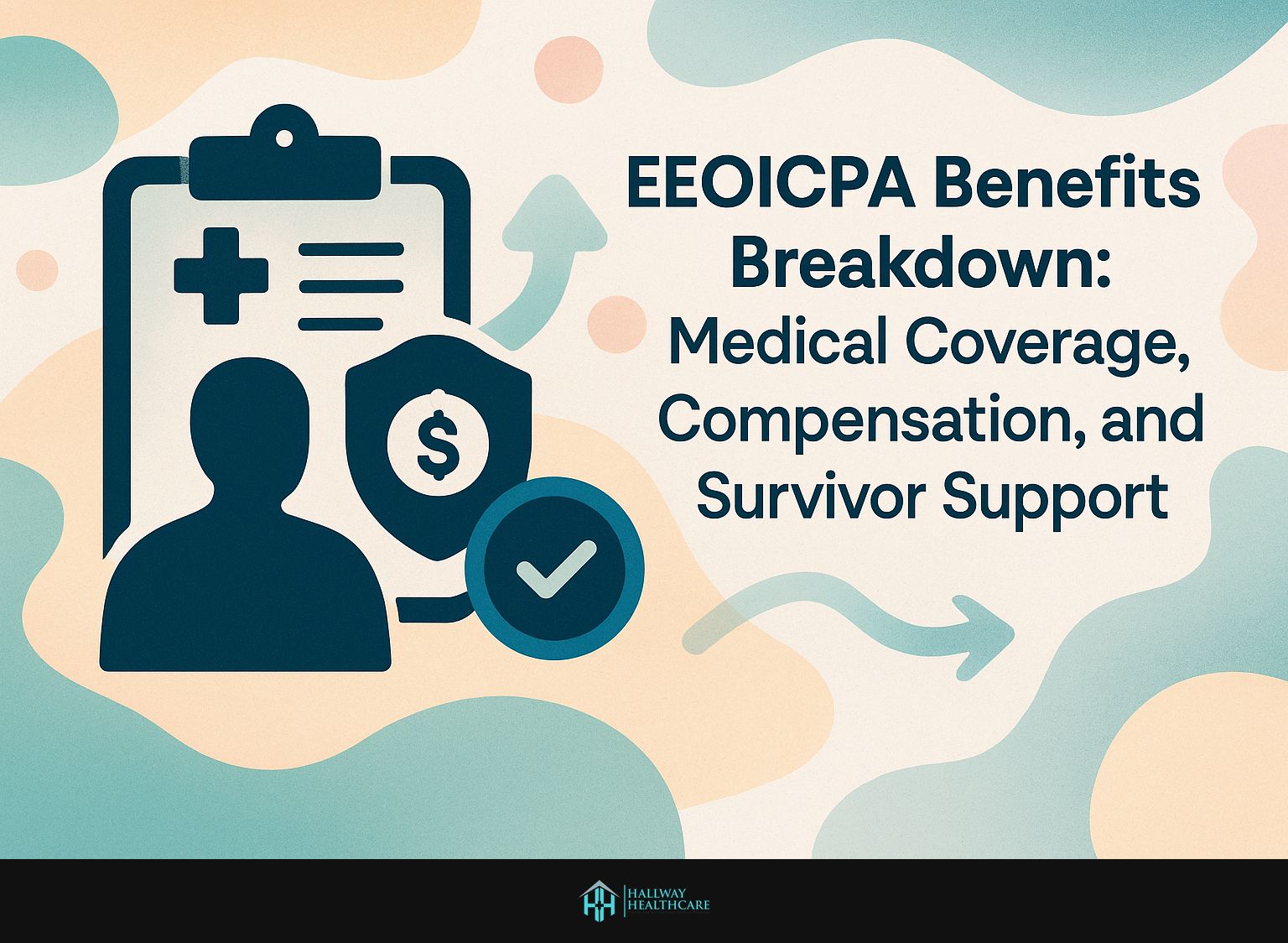
Navigating EEOICPA benefits can be complex. Understanding your rights and eligibility is essential. The EEOICPA supports those affected by chronic beryllium disease, occupational asthma, and other health issues from their work in Department of Energy facilities. In this article, we break down medical coverage, compensation options under Part E, eligibility criteria, including for survivors and their benefits, ensuring you have the information needed to secure the benefits you deserve.
Key Takeaways:
- EEOICPA provides medical coverage, compensation, and survivor support for individuals affected by exposure to radioactive materials
- To be eligible for EEOICPA benefits, individuals must have a qualifying medical condition and proof of employment at a covered facility
- Survivors of eligible workers, including spouses, natural children, and step-children, may also receive medical coverage and compensation, but must go through a separate application process
Overview of EEOICPA
The Energy Employees Occupational Illness Compensation Program Act (EEOICPA) was established to provide compensation to workers who developed illnesses as a result of exposure to toxic substances while employed at Department of Energy facilities. This act outlines a comprehensive framework for compensating affected employees and includes specific provisions for health benefits and compensation benefits.
Eligible workers may receive monetary compensation for covered illnesses, in addition to access to medical care through the Department of Labor.
To start a claim, employees must submit their employment history, financial, and legal documents. A diagnosis from a qualified physician is also required. It is essential to familiarize yourself with the list of covered illnesses, including various cancers, chronic respiratory diseases, and chronic renal failure. This knowledge helps in navigating the claims process and obtain the necessary support.
Thorough medical records are crucial. They should detail each visit, diagnosis, and treatment plan. Include employment records like pay stubs and letters that confirm the claimant’s position and salary.
History and Purpose
Enacted in 2000, the Energy Employees Occupational Illness Compensation Program Act (EEOICPA) was established in response to the increasing awareness of occupational illnesses among workers in Department of Energy (DOE) facilities, with the aim of providing essential support to these individuals.
The Act was a response to significant milestones, including the 1990 congressional hearings that highlighted the considerable health risks faced by workers who were exposed to toxic substances and radiation. With the primary objective of compensating individuals affected by illnesses such as cancer and silicosis, EEOICPA instituted a structured process for these workers to file claims.
Importantly, the Act also provides medical benefits and compensation for survivors, ensuring families receive support. Its relevance continues today, as health studies highlight exposure risks in these facilities, reinforcing the Act’s mission.
Eligibility
Understanding the eligibility criteria is essential for potential claimants seeking benefits under the Energy Employees Occupational Illness Compensation Program Act (EEOICPA), as it delineates the individuals who are entitled to compensation program benefits and medical care.
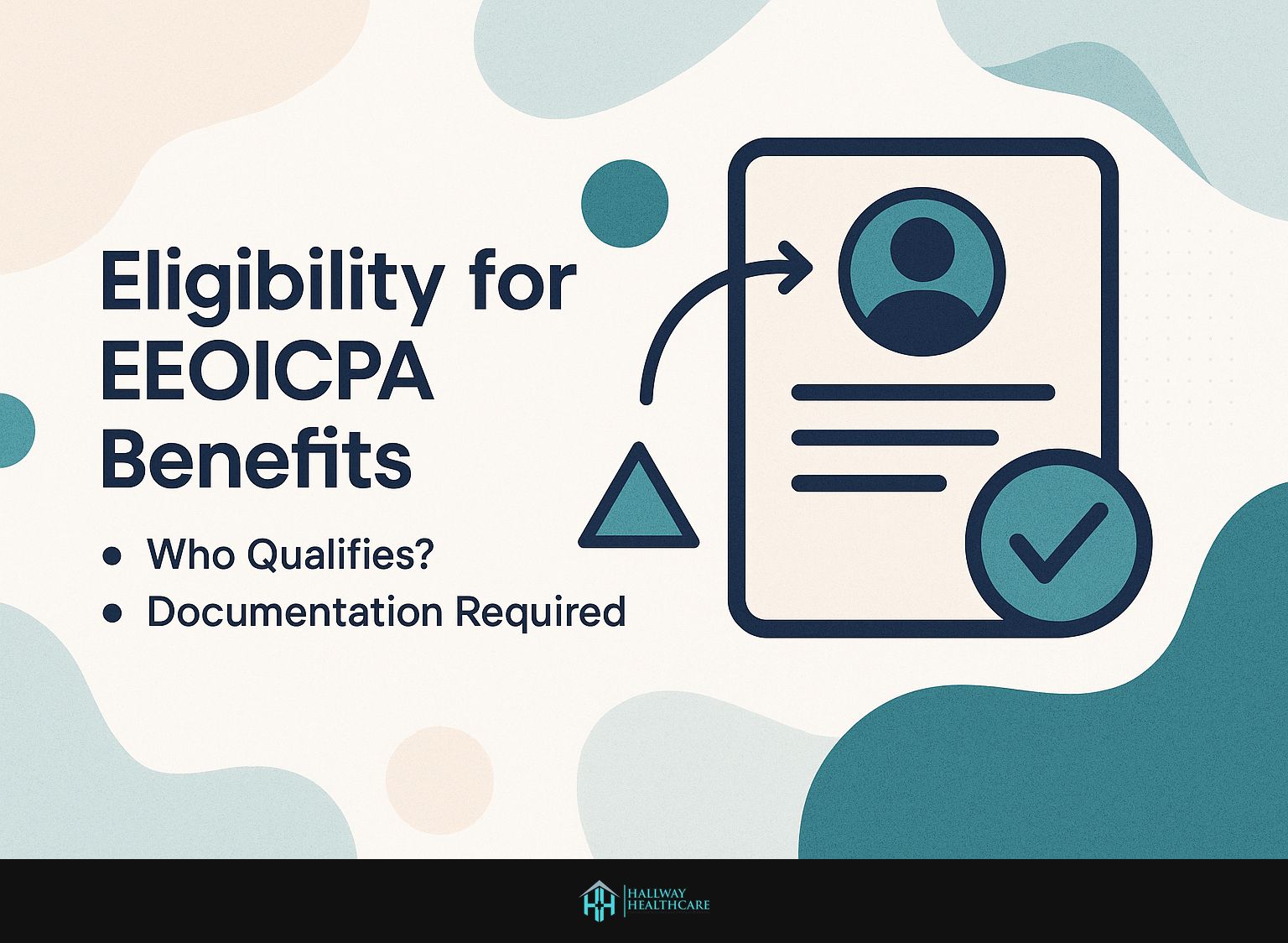
Who is Eligible for Benefits?
Eligibility under EEOICPA includes current or former Department of Energy (DOE) employees and certain survivors who can prove qualifying illnesses.
To qualify under the EEOICPA, individuals must provide evidence of specific occupational illnesses, which include:
- Chronic Beryllium Disease (CBD): A serious lung condition resulting from exposure to beryllium.
- Chronic Silicosis: Another lung disease caused by the inhalation of silica dust, often affecting uranium miners.
- Other covered conditions: Various forms of cancer related to exposure.
Survivors must provide documents proving their deceased family member’s employment at a qualified facility and their illness.
Documentation Required
Claimants must submit specific documents, including medical evidence of the illness, employment records, and legal papers to support their applications.
Thorough medical records are crucial. They should detail each visit, diagnosis, and treatment plan. Additionally,
Include employment records like pay stubs and letters that confirm the claimant’s position and salary.
Claimants must keep all documentation and receipts for a smooth reimbursement process. Selecting healthcare providers familiar with EEOICPA guidelines is crucial to avoid issues with claims and ensure proper health management.
EEOICPA Medical Coverage
The Energy Employees Occupational Illness Compensation Program Act (EEOICPA) offers medical coverage to eligible claimants, providing access to treatments for occupational diseases.
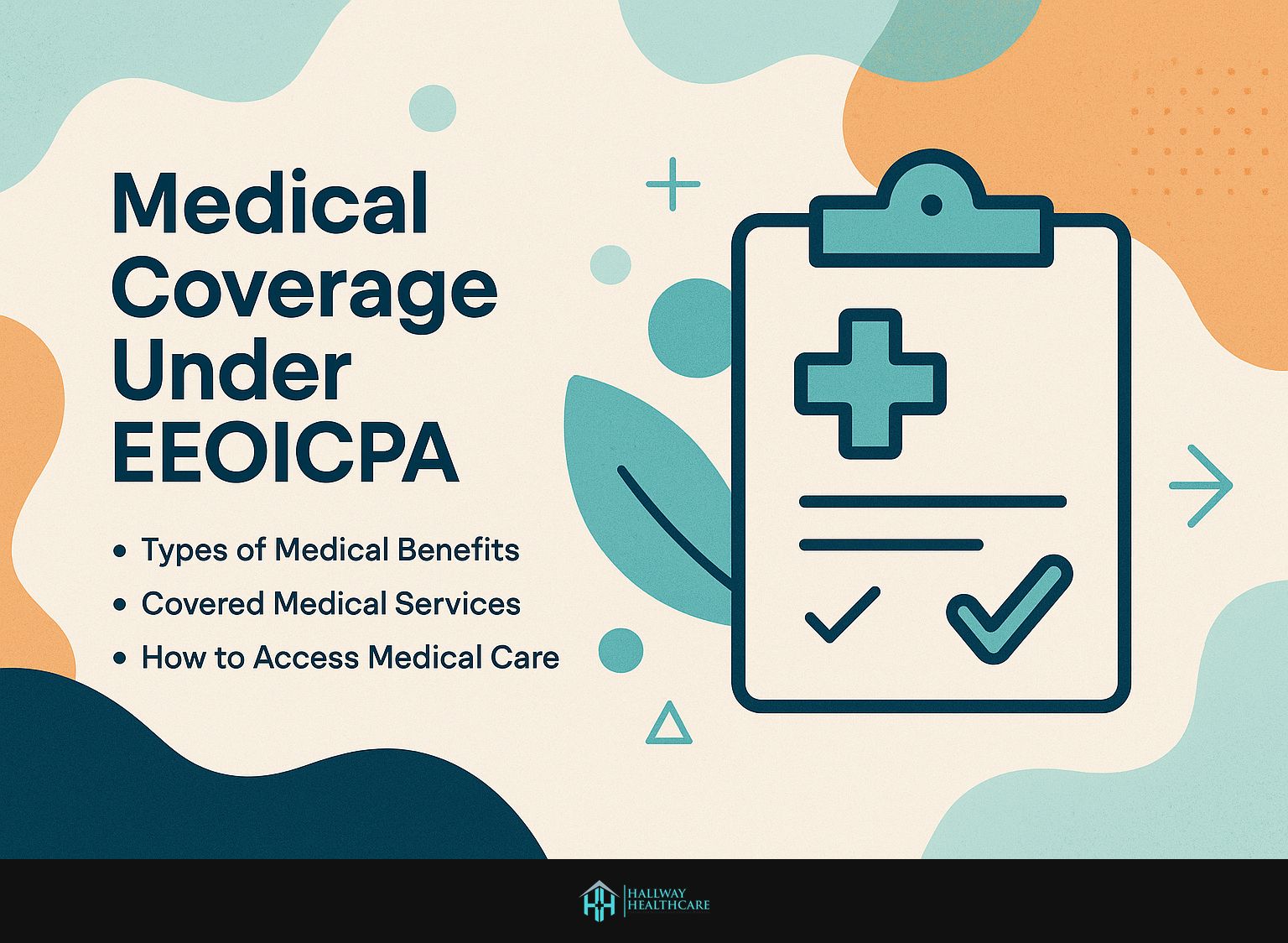
Types of Medical Benefits
Eligible claimants receive various medical benefits, covering treatments for chronic diseases due to occupational exposures. These health benefits may encompass comprehensive coverage for conditions such as cancer, respiratory diseases, chronic renal failure, and cardiovascular disorders.
Many plans cover treatments like chemotherapy and pulmonary rehabilitation. This significantly reduces the financial burden on individuals. It is imperative for claimants to thoroughly review the specific policy documents or consult with a claims advisor to understand their benefits, including co-payments and waiting periods.
Using resources like annual health assessments ensures patients receive eligible treatments without delays.
Covered Medical Services
Covered services include physician visits, hospitalizations, and necessary medications for eligible conditions.
Claimants can access services like diagnostic testing, surgeries, and rehabilitation therapies. For instance, diagnostic imaging, such as MRIs, is often needed for conditions related to occupational exposure. Medications prescribed by licensed healthcare providers are covered if necessary for diagnosed conditions.
Claimants must keep all documentation and receipts for a smooth reimbursement process. Additionally, selecting healthcare providers familiar with EEOICPA guidelines is crucial to avoid issues with claims and ensure proper health management.
How to Access Medical Care
Claimants can access medical care through providers who accept EEOICPA benefits, ensuring treatment meets program requirements.
To find authorized providers, start by visiting the Department of Labor’s EEOICPA website for a list of approved healthcare professionals. Once a provider is identified, contact them to verify their participation in the program.
To navigate the claims process, gather all relevant medical records and complete the necessary claim forms. Using resources like the Department of Labor’s online claims tracker helps claimants monitor their submission status effectively.
Joining support groups offers valuable insights, as members share experiences and advice on navigating the system.
Compensation for Workers
Compensation benefits under the EEOICPA support workers affected by illnesses from toxic exposures.
These benefits provide essential financial relief in various forms.
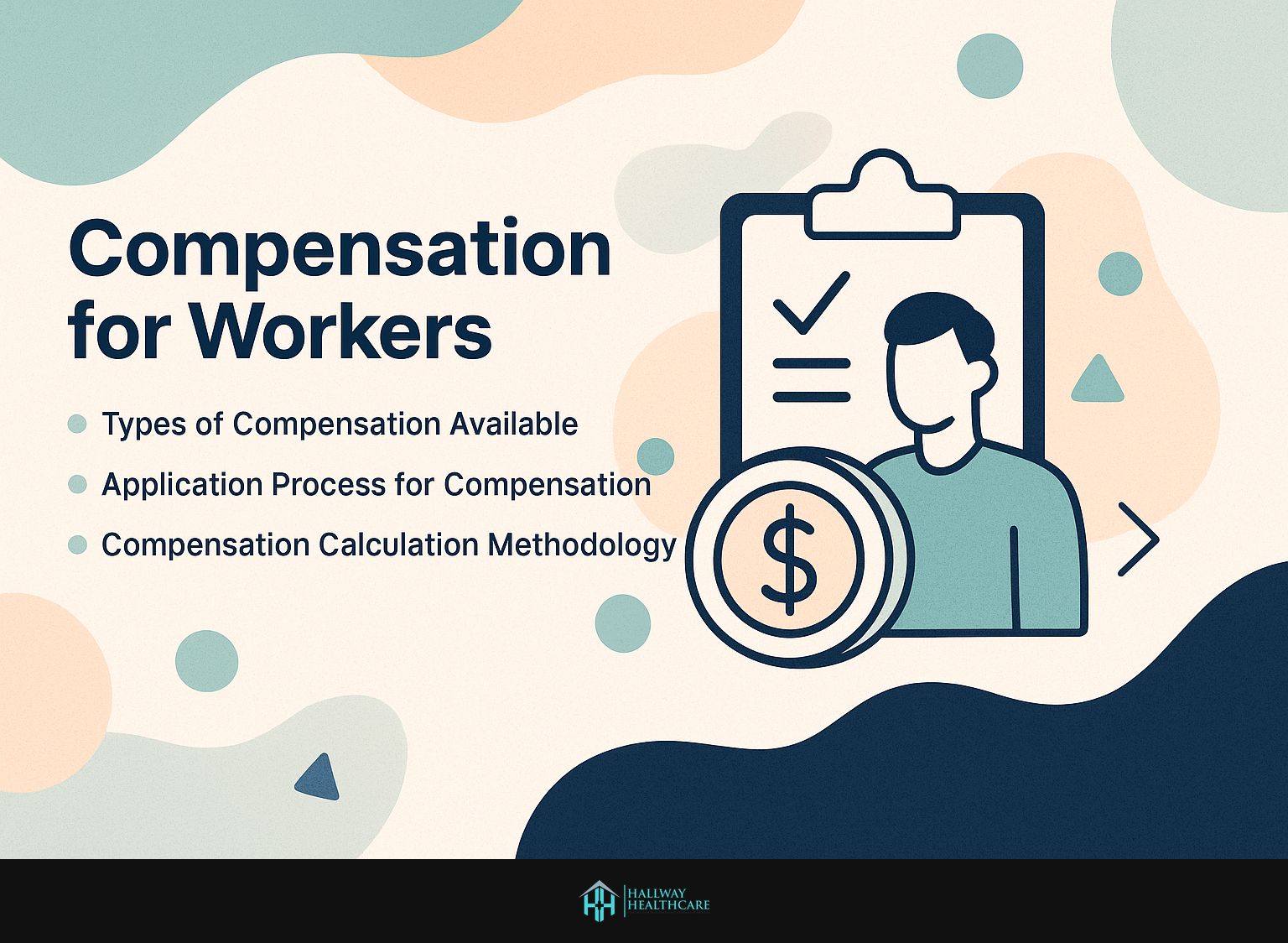
Compensation Options Available
The program offers various compensation options. These include lump sum payments for diagnosed illnesses and ongoing benefits for eligible survivors.
Lump sum payments provide immediate financial support for specific illnesses like cancer. They help cover medical expenses.
Beneficiaries must understand these distinctions. This knowledge helps them make informed decisions about applicable compensation.
Application Process for Compensation
Applying for compensation under the Energy Employees Occupational Illness Compensation Program Act (EEOICPA) involves several essential steps, including the collection of medical evidence, completion of required forms, and submission of claims to the relevant authorities such as the Department of Labor and Department of Justice.
Steps to Apply for Compensation
- The initial task is to gather the necessary documents, which may include proof of employment, medical records, and any pertinent evidence of radiation exposure, particularly from DOE facilities.
- Following this, it is important to complete the designated forms, specifically Form EE-1 for initial claims. These forms are available on the U.S. Department of Labor’s website.
- Once the forms are completed, claims should be submitted either online or by mail to the appropriate district office, ensuring proper claim filing procedures are followed.
For assistance, contact the EEOICPA Help Desk at 1-866-888-3322. This systematic approach is designed to streamline the application process and improve the likelihood of approval.
Compensation Calculation Methodology
Compensation amounts depend on several factors. These include the illness type, exposure extent, and financial documents verifying lost wages.
Claimants need to submit essential financial documents to determine compensation. This includes documents related to lost wages. These may include:
- Pay stubs
- Tax returns
- Medical bills
The calculation often employs a formula that considers past earnings in relation to the impact of the diagnosed condition on earning capacity. For example, if an individual could have earned $50,000 annually but was unable to work due to exposure, the compensation may be calculated based on lost wages for the duration of the affected employment.
This approach ensures that claims are both substantiated and equitable.
Survivor Support Benefits
Survivor support benefits under the EEOICPA help families of workers who died from occupational illnesses. They provide crucial financial assistance.
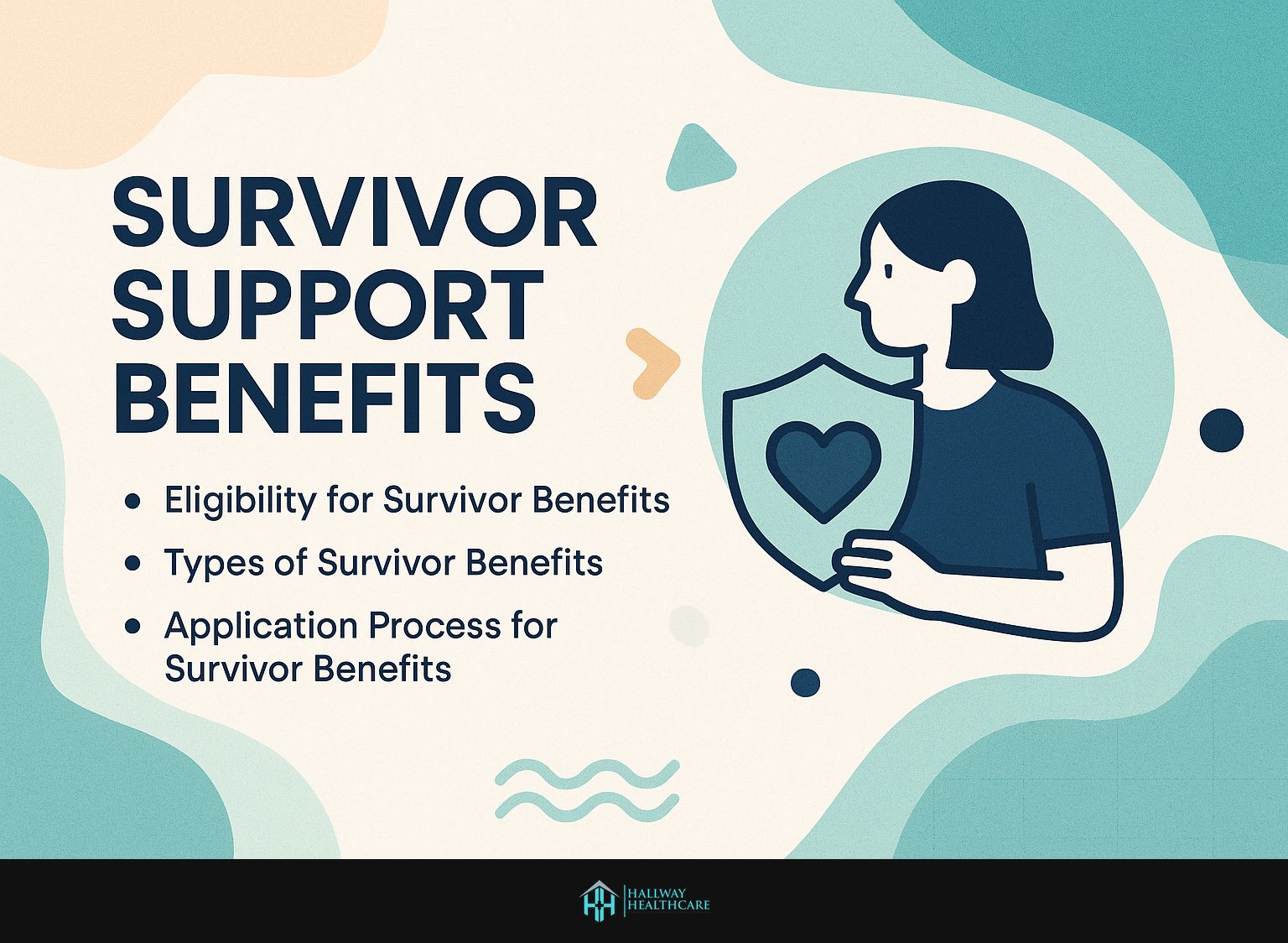
Eligibility
Survivor benefits typically extend to spouses, children, and other dependents. They must prove their relationship to the deceased employee. To qualify, spouses are generally required to have been married for a minimum of one year prior to the employee’s passing.
Natural children may claim benefits if they are biological offspring, regardless of their age; however, minor children may need documentation to claim benefits. Step-children are also eligible, provided they relied on the employee for at least half of their financial support.
In some areas, common-law spouses may qualify. They must prove their relationship according to local laws.
Review specific regulations ahead of time. Gather necessary documents like birth certificates or marriage licenses before filing claims.
Types of Survivor Benefits
Survivors may qualify for various benefits. These include health coverage, lump sum payments, and ongoing support for living expenses.
Health coverage includes medical treatments, mental health services, and prescription medications. This ensures that survivors can meet their physical and emotional needs.
Lump sum payments offer immediate financial help. They can cover funeral costs or settle debts, while ongoing support helps with daily expenses like rent and utilities.
Survivors should contact local support organizations like the Red Cross or community health services. They can provide personalized information and guidance on the application process.
Application Process
Applying for survivor benefits requires specific documents. This includes proof of relationship and evidence of the deceased’s occupational exposure.
Gather these documents for a successful claim:
- A marriage certificate or divorce decree to establish the relationship
- The deceased’s death certificate
- Work history records confirming the deceased’s occupational exposure
Letters from coworkers can help. They attest to the deceased’s work conditions, especially for radiation exposure claims.
Use the Social Security Administration’s online toolkit to navigate the application process. Reviewing all documents carefully will prevent delays.
Challenges and Common Issues
Claimants often face challenges with the Energy Employees Occupational Illness Compensation Program Act (EEOICPA). Common issues include claim denials and a complex appeals process.
Claim Denials and Appeals
Claim denials can happen for many reasons. Insufficient documentation or not meeting eligibility criteria often causes these denials.
First, understand why your claim was denied. This information is in the denial letter.
Submit your appeal within the timeline noted in the denial notice. This usually ranges from 30 to 180 days.
After you submit, follow up with the insurer. Confirm they received your appeal and ask about the timeline for a decision.
Summary of Benefits
The EEOICPA offers vital benefits, including medical coverage and compensation. These are crucial for the health and financial stability of eligible individuals.
Claimants must complete detailed applications to access these benefits. They need to provide medical documentation and proof of employment in designated facilities.
Start by visiting the Department of Labor’s EEOICPA website. Here, claimants can find necessary forms and detailed instructions.
Gather documents like work history and medical records. These support the claim.
Use tools like the Online Claims Assistant for valuable guidance throughout the claims process.
After submitting the application, claimants should expect possible follow-up inquiries. They are encouraged to seek help from local support organizations to navigate the claims process effectively.
Future of EEOICPA
The future of the Energy Employees Occupational Illness Compensation Program Act (EEOICPA) depends on continued advocacy and potential legislative updates to better support workers affected by toxic exposures.
Advocacy groups are pushing for more funding and simpler claims processes. This ensures timely help for affected workers.
Proposed changes may expand eligibility criteria to include more illnesses linked to toxic exposure.
Organizations like the Alliance of Atomic Veterans and local unions are working together to raise awareness and lobby for these important updates.
Engaging with policymakers through letters and organized events is crucial to amplifying the voices of those impacted.
It is vital for affected workers to get involved in these advocacy efforts.
Final Thoughts
Navigating the Energy Employees Occupational Illness Compensation Program Act (EEOICPA) can be challenging. Understanding the program’s benefits and application processes can help claimants secure necessary support.
Claimants should start by gathering necessary documents, including medical records and employment history.
Using resources like the Department of Energy’s EEOICPA website is advisable. It provides detailed guidelines and necessary forms.
Reaching out to local advocacy groups or legal aid services specializing in EEOICPA claims is recommended. They can offer personalized help and expert advice.
Staying organized and seeking the right help can greatly improve the chances of a successful claim. This will help individuals access the benefits they deserve.
 Skip to content
Skip to content
